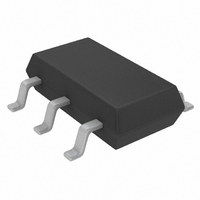LTC1734ES6-4.1#TRMPBF Linear Technology, LTC1734ES6-4.1#TRMPBF Datasheet - Page 9

LTC1734ES6-4.1#TRMPBF
Manufacturer Part Number
LTC1734ES6-4.1#TRMPBF
Description
IC BATT CHRGR LI-ION LIN SOT23-6
Manufacturer
Linear Technology
Datasheet
1.LTC1734ES6-4.2TRMPBF.pdf
(12 pages)
Specifications of LTC1734ES6-4.1#TRMPBF
Function
Charge Management
Battery Type
Li-Ion, NiCd, NiMH
Voltage - Supply
4.55 V ~ 8 V
Operating Temperature
-40°C ~ 85°C
Mounting Type
Surface Mount
Package / Case
SOT-23-6 Thin, TSOT-23-6
Lead Free Status / RoHS Status
Lead free / RoHS Compliant
Other names
LTC1734ES6-4.1#PBF
LTC1734ES6-4.1#PBF
LTC1734ES6-4.1#PBF
Available stocks
Company
Part Number
Manufacturer
Quantity
Price
APPLICATIONS
Monitoring Charge Current
The voltage on the PROG pin indicates the charge current
as a proportion of the maximum current set by the
program resistor. The charge current is equal to 1000 •
(V
ler with an ADC to easily monitor charge current and if
desired, manually shut down the charger at the appropri-
ate time. See Figure 1 for an example. The minimum PROG
pin current is about 3 A (I
Errors in the charge current monitor voltage on the PROG
pin are inversely proportional to battery current and can be
statistically approximated as follows:
Dynamic loads on the battery will cause transients to
appear on the PROG pin. Should they cause excessive
errors in charge current monitoring, a simple RC filter as
shown in Figure 2 can be used to filter the transients. The
filter will also quiet the PROG pin to help prevent inadvert-
ent momentary entry into the manual shutdown mode.
Because the PROG pin is in a closed-loop signal path the
pole frequency must be kept high enough to maintain
adequate AC stability. This means that the maximum
resistance and capacitance presented to the PROG pin
must be limited. See the Stability section for more details.
Constant Current Source
The LTC1734 can be used as a constant current source by
disabling the voltage control loop as shown in Figure 3.
This is done by pulling the BAT pin below the preset float
voltages of 4.1V or 4.2V by grounding the BAT pin. The
program resistor will determine the output current. The
output current range can be between approximately 50mA
and 700mA, depending on the maximum power rating of
the external PNP pass transistor.
External PNP Transistor
The external PNP pass transistor must have adequate
beta, low saturation voltage and sufficient power dissipa-
tion capability (including any heat sinking, if required).
To provide 700mA of charge current with the minimum
available base drive of approximately 30mA requires a
PNP beta greater than 23. If lower beta PNP transistors are
PROG
One Sigma Error(%) 1 + 0.3/I
/R
PROG
) amps. This feature allows a microcontrol-
U
INFORMATION
U
PROGPU
).
BAT
W
(A)
U
used, more base current is required from the LTC1734.
This can result in the output drive current limit being
reached, or thermal shutdown due to excessive power
dissipation. Excessive beta can affect AC stability (see
Stability section)
With low supply voltages, the PNP saturation voltage
(V
than the minimum supply voltage minus the maximum
voltage drop across the internal sense resistor and bond
wires (0.1 ) and battery float voltage. If the PNP transis-
tor can not achieve the low saturation voltage required,
base current will dramatically increase. This is to be
avoided for a number of reasons: output drive may reach
current limit resulting in the charger’s characteristics to
go out of specifications, excessive power dissipation may
force the IC into thermal shutdown, or the battery could
become discharged because some of the current from the
DRIVE pin could be pulled from the battery through the
forward biased collector base junction.
For example, to program a charge current of 500mA with
a minimum supply voltage of 4.75V, the minimum operat-
ing V
The actual battery charge current (I
than the expected charge current because the charger
senses the emitter current and the battery charge current
will be reduced by the base current. In terms of (I
I
If = 50, then I
be compensated for by increasing I
Another important factor to consider when choosing the
PNP pass transistor is the power handling capability. The
transistor’s data sheet will usually give the maximum rated
power dissipation at a given ambient temperature with a
power derating for elevated temperature operation. The
maximum power dissipation of the PNP when charging is:
V
the minimum battery voltage when discharged.
BAT
DD(MAX)
CESAT
V
I
P
BAT
CE(MIN)
D(MAX)
can be calculated as follows:
CE
(A) = 1000 • I
) becomes important. The V
is:
is the maximum supply voltage and V
(W) = I
(V) = 4.75 – (0.5)(0.1) – 4.2 = 0.5V
BAT
BAT
is 2% low. If desired, the 2% loss can
PROG
(V
DD(MAX)
[ /( + 1)]
– V
BAT
PROG
BAT(MIN)
CESAT
) is slightly smaller
by 2%.
LTC1734
must be less
)
BAT(MIN)
C
/I
9
B
is
),














